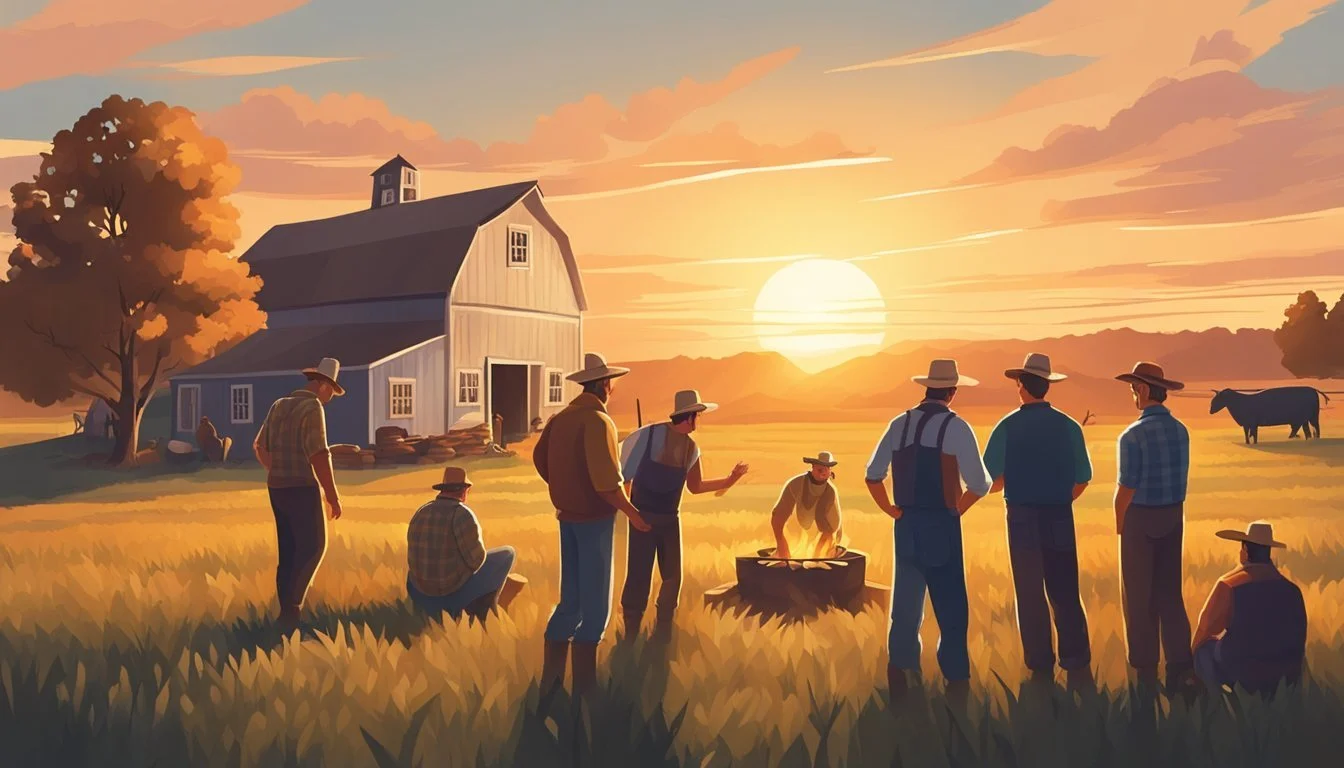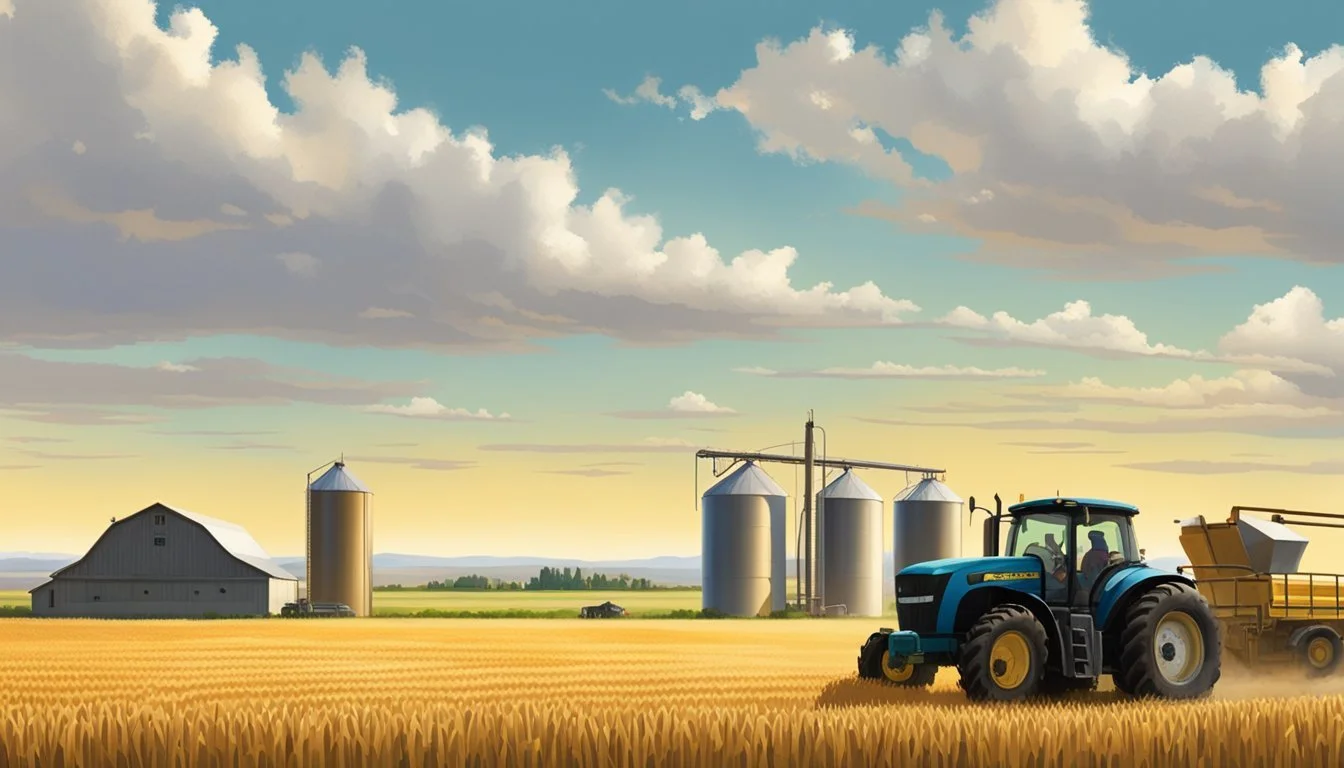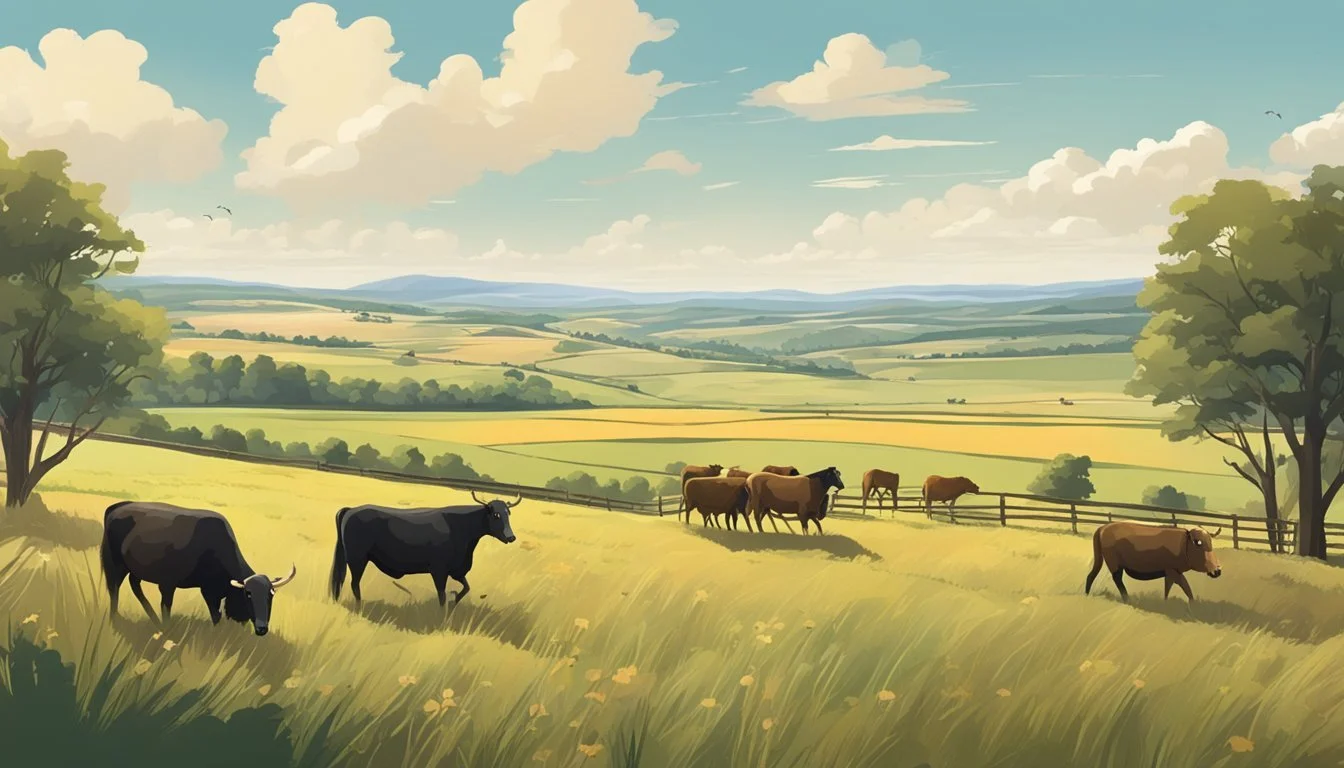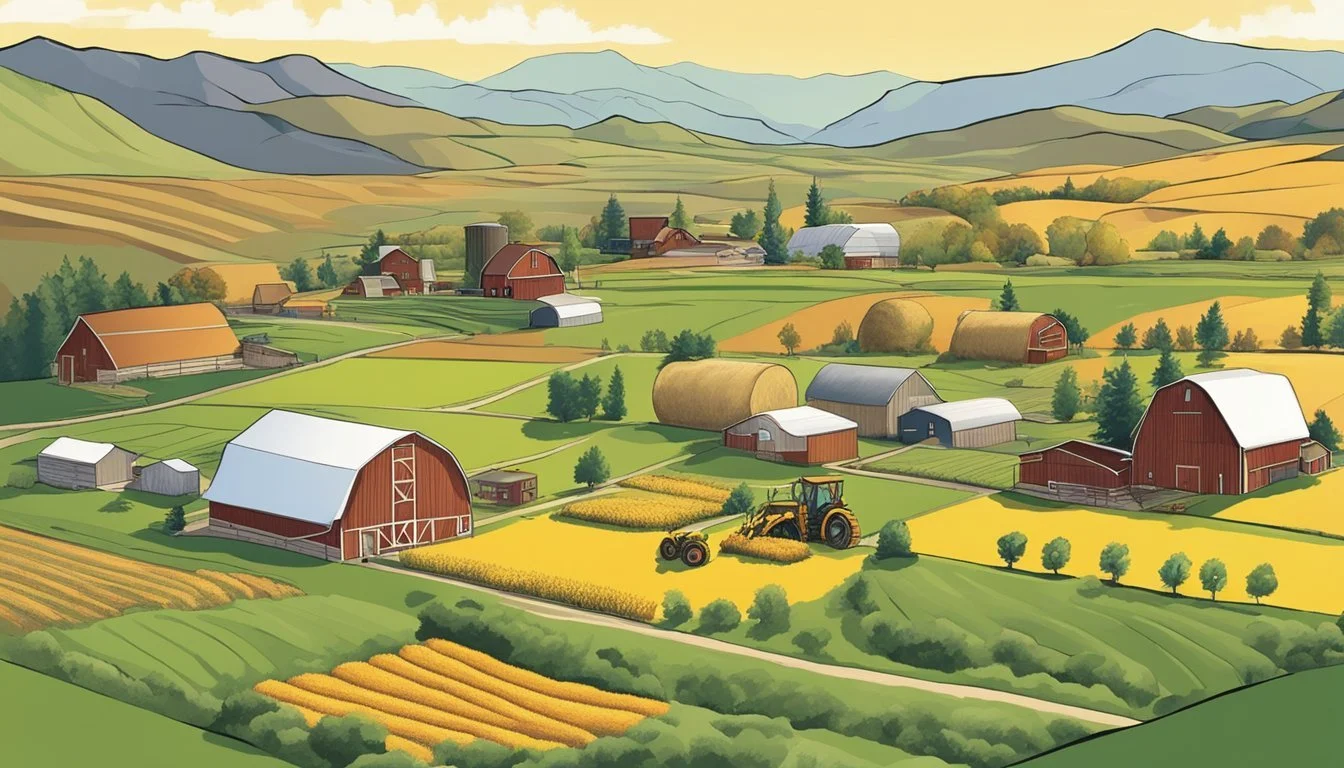Farming Communities in Wyoming
Sustaining Tradition and Innovation
Nestled in the heart of the American West, Wyoming's farming communities embody the spirit of rural life, where agriculture reigns supreme. Spanning across breathtaking landscapes, Wyoming's ranches and farms offer a blend of tradition and innovation that sustains the local economy and way of life. The vast open spaces and fertile land support a variety of crops and livestock, contributing to a robust agricultural sector that is crucial to both the state and the nation.
Agricultural properties in Wyoming range from small family farms to expansive commercial ranches, providing diverse opportunities for farming ventures. With approximately 600,000 acres of ranches and around 200,000 acres of farmland currently available for sale, Wyoming remains an ideal location for those looking to invest in agricultural real estate. The combination of affordable land prices and the state's favorable conditions for farming make it a coveted destination for new and experienced farmers alike.
Wyoming's farming communities are also known for their rich heritage and strong community bonds. These communities not only produce high-quality agricultural products but also serve as a testament to the enduring values of hard work, resilience, and cooperation. The unique blend of tradition and modern agricultural practices makes Wyoming's farming communities fascinating, practical, and essential to explore.
History of Farming Communities in Wyoming
Wyoming's farming communities evolved significantly from interactions between settlers and Native Americans to developments in homesteading, railroads, and ranching. These elements shaped the agricultural landscape we recognize today.
Early Settlers and Native Americans
Early farming in Wyoming was influenced by Native American tribes, who had been living off the land for centuries. Tribes such as the Shoshone, Arapaho, and Cheyenne relied on buffalo and other game, utilizing the plains for hunting and gathering.
European settlers began arriving in the 19th century, drawn by opportunities for land and resources. These settlers often clashed with Native Americans as they established farms and ranches. Initial farming efforts were rudimentary, relying heavily on the surrounding environment.
Interactions between the groups were complex, involving both conflict and cooperation. These early days set the stage for further agricultural advancements as European farming techniques began to take hold.
Homesteading and Railroads Expansion
The Homestead Act of 1862 was pivotal in Wyoming's agricultural history. It allowed settlers to claim up to 160 acres of land, provided they improved it with farming. Thousands of settlers migrated to Wyoming, transforming vast rangelands into productive farms.
Railroad expansion further spurred agricultural development. The Union Pacific Railroad, completed in 1869, connected Wyoming to larger markets. Farmers could now transport crops and livestock more efficiently, fostering economic growth.
Homesteading created a diverse farming community, with settlers from various backgrounds converging in Wyoming. This period also saw the introduction of new farming techniques, irrigation methods, and crop varieties, adapting to the semi-arid climate.
The Development of Ranching
Ranching became central to Wyoming's agricultural identity, particularly with the rise of the cattle industry. By 1868, the Wyoming cattle boom began, lasting until 1886. This period saw vast herds roaming the plains, managed by skilled cowboys and ranchers.
Cattle drives were a common sight, with ranches stretching across the landscape. Historic ranches, such as the Gothberg Ranch near Casper, played a significant role in preserving the state's ranching culture. Ranchers faced challenges, including harsh winters and competition from the growing sheep industry.
Ranching not only shaped the economy but also the cultural fabric of Wyoming, embedding the image of the rugged cowboy and open plains into the state's identity.
Geography and Natural Resources
Wyoming's diverse geography and abundant natural resources significantly shape its farming communities. Key geographic features like the Bighorn Mountains and numerous rivers impact land use, water rights, and conservation efforts.
Bighorn and Big Horn Mountains
The Bighorn Mountains and Big Horn Mountains stand as significant geographic features in Wyoming. They stretch across northern Wyoming, influencing local climate and vegetation. The mountains provide critical water sources that feed into the surrounding valleys, supporting agricultural activities.
These mountain ranges are also home to various ecosystems, from forests to alpine meadows. The vegetation influences grazing patterns and wildlife habitats. Farming communities rely on these ecosystems to maintain healthy grazing lands for livestock, making proper management essential.
Farmers and land managers must collaborate on conservation practices to preserve the health of these mountainous areas. Soil erosion and deforestation are continual threats that need addressing to maintain the natural balance and agricultural productivity.
Rivers and Creeks Impact
Wyoming's numerous rivers and creeks, like the North Platte River, are crucial for farming communities. These water bodies provide essential irrigation to sustain crops in Wyoming's semi-arid environment. Access to water from rivers and creeks ensures the viability of agricultural land, supporting both crop cultivation and livestock.
Water rights are a significant concern, given the limited water resources. Legal frameworks govern these rights to ensure fair distribution among farmers and other stakeholders. Irrigation systems, some dating back over a century, are still in use to optimize water usage for farming.
Efforts to manage these water sources include the use of modern irrigation technologies to reduce water wastage. Balancing water use between agricultural needs and ecological sustainability remains a focal point.
Conservation and Land Management
Conservation and land management practices are fundamental in maintaining Wyoming's agricultural productivity and natural beauty. Organizations like the Natural Resources Conservation Service (NRCS) provide technical assistance and financial support to farmers. These programs aim to promote sustainable practices that protect soil, water, and wildlife.
Crop rotation, no-till farming, and organic agriculture are some methods encouraged to maintain soil health. Proper land management prevents soil degradation and promotes long-term agricultural viability.
Grazing management is also a critical aspect, involving the careful monitoring of livestock to prevent overgrazing. Protecting plant life and minimizing erosion helps sustain the land for future farming needs. Conservation efforts ensure that Wyoming’s natural resources continue to support its farming communities.
Agricultural Production
Wyoming's agricultural production presents a varied landscape of livestock and crop cultivation, deeply influencing the state's economy and communities. Key areas include cattle and sheep ranching, along with crop production bolstered by strategic irrigation.
Cattle and Sheep Ranching
Cattle ranching is a significant aspect of Wyoming's agricultural economy. As of recent data, the state supports around 1.55 billion dollars in cash receipts from cattle and calves alone. Many ranches utilize vast grazing lands extending over millions of acres, enabling large-scale livestock farming.
Sheep ranching also plays a crucial role, with Wyoming being one of the top producers of wool in the United States. Ranches often balance cattle and sheep, optimizing land use and grazing resources. The integration of these practices helps sustain the local economy, supporting communities and maintaining the cultural heritage of the region.
Crop Production and Irrigation
Crop production in Wyoming covers various grains, vegetables, and hay. The state attributes much of its cultivated success to the efficient use of irrigation, vital in the semi-arid climate. Farmers deploy advanced irrigation methods to maximize yields despite challenging weather conditions.
Alfalfa, barley, and sugar beets are among the primary crops. The strategic use of water resources ensures consistent production, contributing substantially to the agricultural output. Moreover, local farming communities benefit from technological advancements in irrigation, which helps mitigate water scarcity and supports sustainable farming practices.
Tables representing the types of crops grown, along with acreage and yield statistics, can be highly informative for stakeholders and researchers analyzing agricultural productivity in Wyoming.
Social and Cultural Life
The social and cultural fabric of Wyoming's farming communities is woven with rich traditions, strong community ties, and a deep connection to the land. These elements ensure not only continuity but also foster pride in the unique lifestyle of rural areas.
Community Events and Traditions
Annual events play a crucial role in sustaining the cultural life of Wyoming's farming communities. County fairs, the Wyoming State Fair in Douglas, and Jubilee Days in Laramie celebrate the region’s Western heritage. These events often include rodeos, showcasing the skills and bravery of local ranchers and promoting communal pride.
Local farmers also host festivals celebrating agritourism, contributing to both cultural cohesion and economic sustenance. These gatherings enable rural communities to come together, share stories, and pass down traditions from one generation to the next.
The Role of Agriculture in Identity
Agriculture forms the backbone of identity in Wyoming's rural communities. The state’s economy heavily relies on farming and ranching, and these activities shape the daily lives and cultural identities of its residents. Pride in agricultural proficiency is a significant cultural marker. Families take immense pride in their roles as producers, maintaining lands that have been in their families for generations.
Ranch life, with its routines and responsibilities, instills a sense of resilience and self-reliance. These qualities are celebrated in local legends, literature, and community stories, reinforcing a collective identity rooted in the land and its bounty.
New Generations and Continuity
The involvement of younger generations is essential for maintaining continuity within farming communities. Local educational programs and 4-H clubs engage youth in agricultural practices, ensuring the transfer of knowledge and skills. Young people learn not only the technical aspects of farming but also the cultural and historical narratives that define their communities.
Prominent initiatives like the Vertical Harvest project blend modern agricultural techniques with traditional community values. By merging hydroponic farming with public-private partnerships, these innovative projects create opportunities for the youth while preserving the cultural essence of Wyoming’s rural communities.
Farmers and ranchers strive to cultivate a sense of pride and love for the land in young people, aiming to keep the story of rural life vibrant and ongoing.
Economic Aspects
Farming communities in Wyoming contribute significantly to the state's economy through employment opportunities and various forms of financial support, including grants and subsidies.
Employment and the Economy
Agriculture in Wyoming is a crucial sector, generating approximately $2.0 billion in agricultural cash receipts in 2022. Key commodities include cattle, calves, hay, and hogs, which are important for the local economy. Beef cattle ranching alone significantly impacts job creation, supporting nearly 60% of agricultural employment.
The agricultural sector adds substantial value to Wyoming's economy, contributing $2.45 billion in 2022. This figure not only includes direct sales but also the processing industries, which constitute 2.4% of the state's total GDP. The far-reaching impact showcases agriculture's role in bolstering employment and sustaining rural communities.
Grants and Financial Support
To support the farming sector, Wyoming offers a variety of financial aid options. This includes state and federal grants aimed at assisting farmers and ranchers. Such financial support is crucial for managing operational costs and promoting sustainable practices.
The USDA and state programs provide funding for resource conservation, technological improvements, and disaster relief. These grants help enhance farm productivity and resilience. Financial support also comes through various Memorandums of Understanding (MOUs) that facilitate collaborative efforts between governmental agencies and farmers, ensuring continuous economic benefits for the agricultural sector.
Recreation and Hunting
Wyoming offers extensive outdoor recreation and hunting opportunities, featuring expansive open spaces and diverse wildlife. The region's natural beauty and resources provide residents and visitors with countless ways to enjoy the outdoors.
Outdoor Activities and Hunting
Wyoming's outdoor enthusiasts can explore numerous parks and open spaces. Activities include camping, hiking, and fishing, making it a haven for nature lovers. Significant areas such as Yellowstone and Grand Teton National Parks offer iconic landscapes and abundant wildlife.
The state also boasts numerous hunting opportunities. From deer and elk to waterfowl, Wyoming's varied habitats support a wide range of game. Specific regions, like Johnson and Fremont counties, highlight premier hunting experiences with access to large tracts of both public and private land.
Innovation in Farming Practices
Wyoming's farming communities are embracing new technologies and strategies to enhance productivity and sustainability. Key areas of focus include vertical farming and advanced water management techniques to address unique challenges.
Vertical Farming and Sustainable Technologies
Vertical farming projects like Vertical Harvest in Jackson are revolutionizing urban agriculture. By using architectural ingenuity and cutting-edge greenhouse technologies, these farms maximize limited space. Vertical farming uses hydroponic systems to grow plants without soil, reducing the need for arable land.
Integrated sustainable technologies such as energy-efficient LED lighting and climate control systems ensure year-round production. This innovation not only increases local food supply but also provides job opportunities in urban settings. Vertical Harvest’s approach is an excellent example of how innovation can lead to sustainable agricultural solutions while supporting community development.
Water Conservation and Management
Water rights and conservation are critical in Wyoming’s arid climate. Farmers are adopting advanced water management practices to ensure sustainable use of this precious resource. Techniques such as drip irrigation and rainwater harvesting significantly improve water efficiency.
Regenerative practices, including the use of biochar, help improve soil health and water retention. Additionally, precision agriculture tools aid in monitoring and managing water use effectively. By implementing these methods, farmers not only conserve water but also enhance crop yields, promoting long-term agricultural sustainability in the region.
Unique Aspects of Wyoming Farming
Wyoming farming is marked by its deep-rooted cowboy culture and the challenges of its semiarid climate.
Role of Cowboy Culture
The cowboy culture is integral to Wyoming's farming communities. Wyoming ranches often have strong ties to traditions of cattle ranching and horse riding.
This aspect is more than just a way of life; it influences the social structure and community events. Rodeos are a common event where ranchers display their skills. The culture dictates practices around cattle herding and livestock management.
Cowboys also play a crucial role in maintaining the health of pastures and managing extensive grazing lands. These traditions have been passed down through generations, embedding themselves in the fabric of Wyoming's agricultural identity.
The Semiarid Climate Challenge
The semiarid climate of Wyoming presents a unique set of challenges for farmers. With limited annual rainfall, often below 15 inches, water management becomes crucial.
Farmers rely heavily on irrigation systems to sustain crops like hay, barley, and corn. The climate also affects soil quality, often requiring techniques to combat erosion and maintain soil health.
Windbreaks are commonly used to reduce the effects of wind erosion. The short growing season and harsh winters further complicate farming efforts. Despite these challenges, innovative practices and a deep understanding of the land help Wyoming farmers to thrive.
Challenges and Future Directions
Wyoming's farming communities are grappling with significant challenges that will shape their future. Key issues include adapting to climate change and navigating policy and regulatory frameworks.
Adapting to Climate Change
Farming communities in Wyoming face increased variability in weather patterns. Droughts are becoming more frequent, posing a threat to water resources essential for farming and ranching. Ranchers and farmers are investing in more efficient irrigation systems and drought-resistant crops to mitigate these effects.
Additionally, changes in temperature affect livestock health and crop yields. Adaptive measures include altering planting dates and diversifying crops. Climate-resilient practices are also being explored to ensure sustained productivity.
Collectively, these measures aim to safeguard Wyoming's agricultural heritage against an uncertain climate future.
Policy and Regulatory Considerations
Navigating policy and regulations is another significant challenge. Wyoming farmers and ranchers must comply with both state and federal regulations that impact land use and environmental practices. Bill Bunce of the USDA has noted that development pressures can lead families to exit the ranching business, impacting local food supplies and air quality.
Policymakers are working on incentives and support programs to encourage sustainable farming practices. This includes financial aid for machinery, as well as subsidies for implementing eco-friendly practices. Engaging in these programs helps farmers remain viable and environmentally responsible.
Ultimately, effective policy and regulatory frameworks are crucial for the long-term viability of Wyoming’s farming communities.










